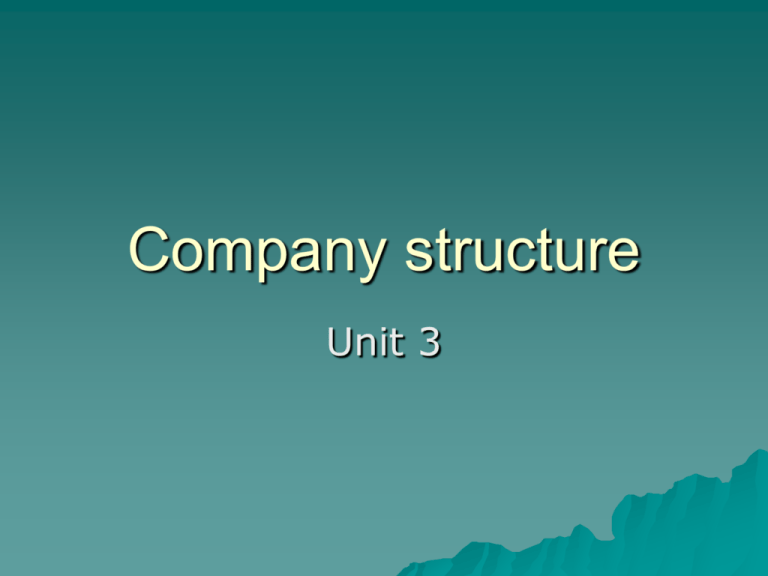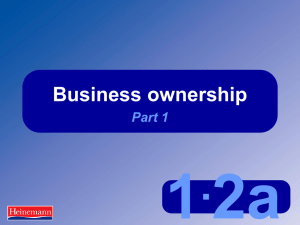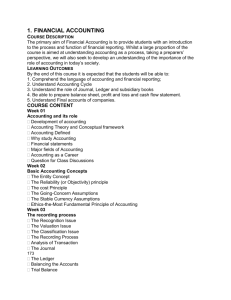Company structure
advertisement

Company structure Unit 3 What is a company ? A company is a form of business organization Generally, a company may be a corporation,partnership, association, joint-stock company, trust, fund, or organized group of persons, whether incorporated or not, Types . 1. A company limited by guarantee. Commonly used where companies are formed for non-commercial purposes, such as clubs or charities. The members guarantee the payment of certain (usually nominal) amounts if the company goes into insolvent liquidation, but otherwise they have no economic rights in relation to the company. This type of company is common in England. 2. A company limited by shares. The most common form of company used for business ventures. Specifically, a limited company is a "company in which the liability of each shareholder is limited to the amount individually invested" with corporations being "the most common example of a limited company." This type of company is common in England. 3. A company limited by guarantee with a share capital. A hybrid entity, usually used where the company is formed for non-commercial purposes, but the activities of the company are partly funded by investors who expect a return. This type of company may no longer be formed in the UK, although provisions still exist in law for them to exist. 4. A limited-liability company. "A company—statutorily authorized in certain states—that is characterized by limited liability, management by members or managers, and limitations on ownership transfer", i.e., L.L.C. 5. An unlimited company with or without a share capital. A hybrid entity, a company where the liability of members or shareholders for the debts (if any) of the company are not limited. Less commonly seen types of companies are: Companies formed by letters patent. Most corporations by letters patent are corporations sole and not companies as the term is commonly understood today. Charter corporations. Before the passing of modern companies legislation, these were the only types of companies. Now they are relatively rare, except for very old companies that still survive (of which there are still many, particularly many British banks), or modern societies that fulfil a quasi regulatory function (for example, the Bank of England is a corporation formed by a modern charter). Statutory Companies. Relatively rare today, certain companies have been formed by a private statute passed in the relevant jurisdiction. Note that "Ltd after the company's name signifies limited company, and PLC (public limited company )) indicates that its shares are widely held." Companies are also sometimes distinguished for legal and regulatory purposes between public companies and private companies. Public companies are companies whose shares can be publicly traded, often (although not always) on a regulated stock exchange. Private companies do not have publicly traded shares, and often contain restrictions on transfers of shares. In some jurisdictions, private companies have maximum numbers of shareholders. Vocabulary : Hierarchical / pyramidal structure – a system, especially in a society or an organization, in which people are organized into different levels of importance from highest to lowest Superior – a person ( in a society or organization ) who is higher in rank, importance or position Subordinate – a person ( in a society or organization ) who has a position with less authority or power than somebody else Line authority – power to give orders from superior to subordinates ( contrasts with Staff Authority ) in a hierarchical or pyramidal structure Chain of command – the system in which orders are transmitted down from a higherranked position to the lower in an organization. The chain of command also means that individual members take orders from only one superior and only give orders to a defined group of people right below them. Functional structure – a structure in an organization, in which people are grouped together into functional or specific departments, each department has its own function ( such as purchasing, accounts, production, sales,marketing.... ) and has a head ( eg. Manager or Director) Department – a section of a large organization or a company that has its own function Decentralize – to give some of the power of a central government, organization... to smaller parts or organizations around the country Division – a large and important unit or section of an organization. A division is a part of a primary business, is not separated from that business, and the primary business is legaly responsible for all of the obligations and debts of the division. Autonomous – able to gavern itself or control its own affairs, able to do things without any help from others











